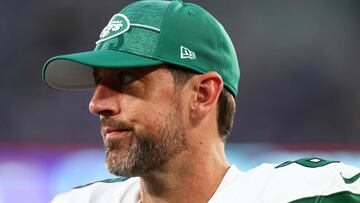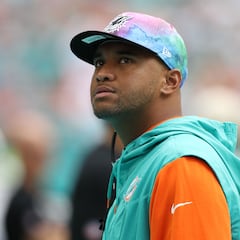What draft position was Aaron Rodgers selected for, and what college did he play for?
It’s ironic to think that Rodgers wasn’t considered to be a future star when the NFL Draft arrived. How wrong the quarterback’s doubters were back then.


Following his shock move from the Green Bay Packers to the New York Jets, four-time NFL MVP quarterback Aaron Rodgers was granted a new lease on life. When he meets the Buffalo Bills on Monday Night Football, however, it will be time for the celebrated playmaker to put his proverbial money where his mouth is.
A look back at Aaron Rodgers’ past
When he was selected out of the University of California in the 2005 NFL Draft, few could have predicted what Aaron Rodgers would become. Several awards, accolades records, and one Super Bowl championship later, the 39-year-old is widely considered the best of his generation and is often described by many as being superior to the legendary seven-time Super Bowl champion, Tom Brady. With all of this in mind, let’s take a look at where Aaron Rodgers came from and where he is today.
College career and NFL draft
Prior to his time at the University of California, Berkeley, Rodgers played football for Butte Community College in Oroville, California. This of course was somewhat of a surprise given his impressive high school record. Yet according to Rodgers himself in a 2011 interview, the shortage of interest from Division 1 schools was largely down to his lack of physical stature - he stood at 5′10″ (1.78 m) and 165 lb (75 kg). Incidentally, Rodgers actually wanted to attend Florida State but was rejected, and while there were others such as the University of Illinois, he ultimately settled on the aforementioned school which was located a short drive away from Chico, California where he was born.
1st time I’ve ever seen highlights of the night Aaron Rodgers brought the Cal Golden Bears to Hattiesburg. M.M. Roberts Stadium was a tough place to play at the time. The Golden Eagles fought hard & almost pulled off a top 10 upset here for the 2nd season in a row. #SMTTT🦅🔝 https://t.co/43jDDLu6Xt
— Jon Patrick Clancy (@ClancyJon) February 27, 2022
In his freshman year, Rodgers would go on to throw 26 touchdowns for Butte CC, leading the school to a 10-1 record, the NorCal Conference championship, and a No. 2 national ranking. It wasn’t long before tongues started wagging, and so it was no surprise when the California Golden Bears’ head coach Jeff Tedford, decided to recruit him. Due to Rodgers’ noteworthy high school scholastic record, he was deemed eligible for transfer to the University of California, Berkeley after one year of junior college instead of the typical two.
Aaron Rodgers’ route to the NFL
As a junior college transfer, Rodgers had three years of eligibility at Cal. He was named the starting quarterback in the fifth game of the 2003 season, the same campaign in which he defeated the single team that had offered him a Division I opportunity out of high school, Illinois. As a sophomore, he helped lead the Golden Bears to a 7–3 record as a starter.
Related stories
Then came his junior year during which he led the team to an impressive 10-1 record and a top-five ranking by the end of the regular season. The team’s only loss was a 23-17 defeat against the top-ranked USC. Rodgers made history in that game by breaking a school record with 26 consecutive completed passes and equaled an NCAA record with 23 successive completed passes in a single game. By the end of the 2004 season, he had registered 2,566 passing yards, thrown 24 touchdowns, and only 8 interceptions. His remarkable 66.1% pass completion rate made him the leader in this category in the Pac-10. As a result of his impressive performance, Rodgers was ranked ninth in the Heisman Trophy voting that year. He then decided to forego his senior year and instead entered the 2005 NFL Draft.
On this day in 2005...
— NFL (@NFL) April 23, 2022
Aaron Rodgers slid to pick No. 24 in the Draft.
📺: 2022 #NFLDraft — April 28-30 on NFLN/ESPN/ABC pic.twitter.com/zute6nMSeL
During the 2005 NFL Draft, the Green Bay Packers selected Rodgers as the 24th overall pick after unexpectedly sliding down the draft board. Rodgers has spoken openly about the anxiety and restlessness he experienced during the draft, as he had anticipated being selected much earlier than he was. Needless to say, that’s in the past now as Rodgers has become a household name. Be sure to catch him against the Buffalo Bills on Monday night at 8:15 p.m. ET.

